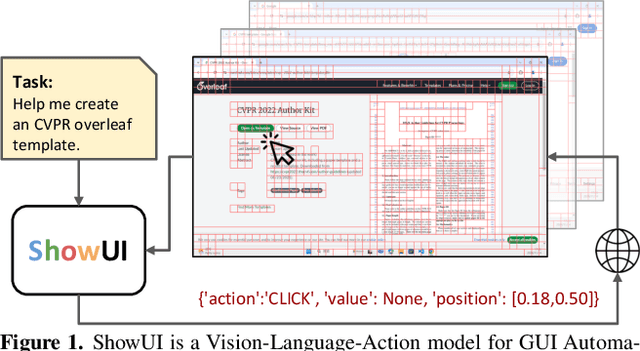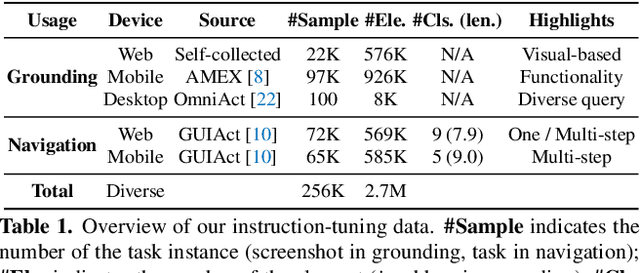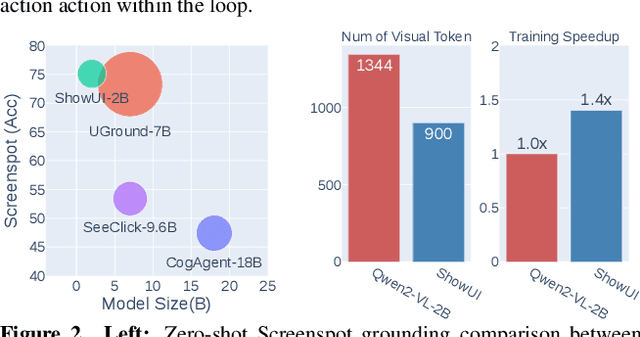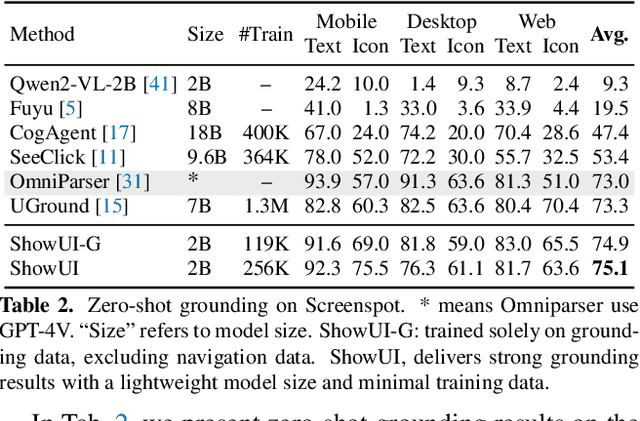Linjie Li
SoTA with Less: MCTS-Guided Sample Selection for Data-Efficient Visual Reasoning Self-Improvement
Apr 10, 2025Abstract:In this paper, we present an effective method to enhance visual reasoning with significantly fewer training samples, relying purely on self-improvement with no knowledge distillation. Our key insight is that the difficulty of training data during reinforcement fine-tuning (RFT) is critical. Appropriately challenging samples can substantially boost reasoning capabilities even when the dataset is small. Despite being intuitive, the main challenge remains in accurately quantifying sample difficulty to enable effective data filtering. To this end, we propose a novel way of repurposing Monte Carlo Tree Search (MCTS) to achieve that. Starting from our curated 70k open-source training samples, we introduce an MCTS-based selection method that quantifies sample difficulty based on the number of iterations required by the VLMs to solve each problem. This explicit step-by-step reasoning in MCTS enforces the model to think longer and better identifies samples that are genuinely challenging. We filter and retain 11k samples to perform RFT on Qwen2.5-VL-7B-Instruct, resulting in our final model, ThinkLite-VL. Evaluation results on eight benchmarks show that ThinkLite-VL improves the average performance of Qwen2.5-VL-7B-Instruct by 7%, using only 11k training samples with no knowledge distillation. This significantly outperforms all existing 7B-level reasoning VLMs, and our fairly comparable baselines that use classic selection methods such as accuracy-based filtering. Notably, on MathVista, ThinkLite-VL-7B achieves the SoTA accuracy of 75.1, surpassing Qwen2.5-VL-72B, GPT-4o, and O1. Our code, data, and model are available at https://github.com/si0wang/ThinkLite-VL.
V-MAGE: A Game Evaluation Framework for Assessing Visual-Centric Capabilities in Multimodal Large Language Models
Apr 08, 2025Abstract:Recent advancements in Multimodal Large Language Models (MLLMs) have led to significant improvements across various multimodal benchmarks. However, as evaluations shift from static datasets to open-world, dynamic environments, current game-based benchmarks remain inadequate because they lack visual-centric tasks and fail to assess the diverse reasoning skills required for real-world decision-making. To address this, we introduce Visual-centric Multiple Abilities Game Evaluation (V-MAGE), a game-based evaluation framework designed to assess visual reasoning capabilities of MLLMs. V-MAGE features five diverse games with 30+ handcrafted levels, testing models on core visual skills such as positioning, trajectory tracking, timing, and visual memory, alongside higher-level reasoning like long-term planning and deliberation. We use V-MAGE to evaluate leading MLLMs, revealing significant challenges in their visual perception and reasoning. In all game environments, the top-performing MLLMs, as determined by Elo rating comparisons, exhibit a substantial performance gap compared to humans. Our findings highlight critical limitations, including various types of perceptual errors made by the models, and suggest potential avenues for improvement from an agent-centric perspective, such as refining agent strategies and addressing perceptual inaccuracies. Code is available at https://github.com/CSU-JPG/V-MAGE.
Measurement of LLM's Philosophies of Human Nature
Apr 03, 2025Abstract:The widespread application of artificial intelligence (AI) in various tasks, along with frequent reports of conflicts or violations involving AI, has sparked societal concerns about interactions with AI systems. Based on Wrightsman's Philosophies of Human Nature Scale (PHNS), a scale empirically validated over decades to effectively assess individuals' attitudes toward human nature, we design the standardized psychological scale specifically targeting large language models (LLM), named the Machine-based Philosophies of Human Nature Scale (M-PHNS). By evaluating LLMs' attitudes toward human nature across six dimensions, we reveal that current LLMs exhibit a systemic lack of trust in humans, and there is a significant negative correlation between the model's intelligence level and its trust in humans. Furthermore, we propose a mental loop learning framework, which enables LLM to continuously optimize its value system during virtual interactions by constructing moral scenarios, thereby improving its attitude toward human nature. Experiments demonstrate that mental loop learning significantly enhances their trust in humans compared to persona or instruction prompts. This finding highlights the potential of human-based psychological assessments for LLM, which can not only diagnose cognitive biases but also provide a potential solution for ethical learning in artificial intelligence. We release the M-PHNS evaluation code and data at https://github.com/kodenii/M-PHNS.
Beyond Words: Advancing Long-Text Image Generation via Multimodal Autoregressive Models
Mar 26, 2025Abstract:Recent advancements in autoregressive and diffusion models have led to strong performance in image generation with short scene text words. However, generating coherent, long-form text in images, such as paragraphs in slides or documents, remains a major challenge for current generative models. We present the first work specifically focused on long text image generation, addressing a critical gap in existing text-to-image systems that typically handle only brief phrases or single sentences. Through comprehensive analysis of state-of-the-art autoregressive generation models, we identify the image tokenizer as a critical bottleneck in text generating quality. To address this, we introduce a novel text-focused, binary tokenizer optimized for capturing detailed scene text features. Leveraging our tokenizer, we develop \ModelName, a multimodal autoregressive model that excels in generating high-quality long-text images with unprecedented fidelity. Our model offers robust controllability, enabling customization of text properties such as font style, size, color, and alignment. Extensive experiments demonstrate that \ModelName~significantly outperforms SD3.5 Large~\cite{sd3} and GPT4o~\cite{gpt4o} with DALL-E 3~\cite{dalle3} in generating long text accurately, consistently, and flexibly. Beyond its technical achievements, \ModelName~opens up exciting opportunities for innovative applications like interleaved document and PowerPoint generation, establishing a new frontier in long-text image generating.
Zero-Shot Audio-Visual Editing via Cross-Modal Delta Denoising
Mar 26, 2025Abstract:In this paper, we introduce zero-shot audio-video editing, a novel task that requires transforming original audio-visual content to align with a specified textual prompt without additional model training. To evaluate this task, we curate a benchmark dataset, AvED-Bench, designed explicitly for zero-shot audio-video editing. AvED-Bench includes 110 videos, each with a 10-second duration, spanning 11 categories from VGGSound. It offers diverse prompts and scenarios that require precise alignment between auditory and visual elements, enabling robust evaluation. We identify limitations in existing zero-shot audio and video editing methods, particularly in synchronization and coherence between modalities, which often result in inconsistent outcomes. To address these challenges, we propose AvED, a zero-shot cross-modal delta denoising framework that leverages audio-video interactions to achieve synchronized and coherent edits. AvED demonstrates superior results on both AvED-Bench and the recent OAVE dataset to validate its generalization capabilities. Results are available at https://genjib.github.io/project_page/AVED/index.html
ImageGen-CoT: Enhancing Text-to-Image In-context Learning with Chain-of-Thought Reasoning
Mar 25, 2025Abstract:In this work, we study the problem of Text-to-Image In-Context Learning (T2I-ICL). While Unified Multimodal LLMs (MLLMs) have advanced rapidly in recent years, they struggle with contextual reasoning in T2I-ICL scenarios. To address this limitation, we propose a novel framework that incorporates a thought process called ImageGen-CoT prior to image generation. To avoid generating unstructured ineffective reasoning steps, we develop an automatic pipeline to curate a high-quality ImageGen-CoT dataset. We then fine-tune MLLMs using this dataset to enhance their contextual reasoning capabilities. To further enhance performance, we explore test-time scale-up strategies and propose a novel hybrid scaling approach. This approach first generates multiple ImageGen-CoT chains and then produces multiple images for each chain via sampling. Extensive experiments demonstrate the effectiveness of our proposed method. Notably, fine-tuning with the ImageGen-CoT dataset leads to a substantial 80\% performance gain for SEED-X on T2I-ICL tasks. See our project page at https://ImageGen-CoT.github.io/. Code and model weights will be open-sourced.
EmoAssist: Emotional Assistant for Visual Impairment Community
Feb 13, 2025Abstract:The rapid advancement of large multi-modality models (LMMs) has significantly propelled the integration of artificial intelligence into practical applications. Visual Question Answering (VQA) systems, which can process multi-modal data including vision, text, and audio, hold great potential for assisting the Visual Impairment (VI) community in navigating complex and dynamic real-world environments. However, existing VI assistive LMMs overlook the emotional needs of VI individuals, and current benchmarks lack emotional evaluation of these LMMs. To address these gaps, this paper introduces the EmoAssist Benchmark, a comprehensive benchmark designed to evaluate the assistive performance of LMMs for the VI community. To the best of our knowledge, this is the first benchmark that incorporates emotional intelligence as a key consideration. Furthermore, we propose the EmoAssist Model, an Emotion-Assistive LMM specifically designed for the VI community. The EmoAssist Model utilizes Direct Preference Optimization (DPO) to align outputs with human emotional preferences. Experiment results demonstrate that the EmoAssist Model significantly enhances the recognition of implicit emotions and intentions of VI users, delivers empathetic responses, and provides actionable guidance. Specifically, it shows respective improvements of 147.8% and 89.7% in the Empathy and Suggestion metrics on the EmoAssist Benchmark, compared to the pre-tuning LMM, and even outperforms state-of-the-art LLMs such as GPT-4o.
TextAtlas5M: A Large-scale Dataset for Dense Text Image Generation
Feb 11, 2025Abstract:Text-conditioned image generation has gained significant attention in recent years and are processing increasingly longer and comprehensive text prompt. In everyday life, dense and intricate text appears in contexts like advertisements, infographics, and signage, where the integration of both text and visuals is essential for conveying complex information. However, despite these advances, the generation of images containing long-form text remains a persistent challenge, largely due to the limitations of existing datasets, which often focus on shorter and simpler text. To address this gap, we introduce TextAtlas5M, a novel dataset specifically designed to evaluate long-text rendering in text-conditioned image generation. Our dataset consists of 5 million long-text generated and collected images across diverse data types, enabling comprehensive evaluation of large-scale generative models on long-text image generation. We further curate 3000 human-improved test set TextAtlasEval across 3 data domains, establishing one of the most extensive benchmarks for text-conditioned generation. Evaluations suggest that the TextAtlasEval benchmarks present significant challenges even for the most advanced proprietary models (e.g. GPT4o with DallE-3), while their open-source counterparts show an even larger performance gap. These evidences position TextAtlas5M as a valuable dataset for training and evaluating future-generation text-conditioned image generation models.
Can MLLMs Reason in Multimodality? EMMA: An Enhanced MultiModal ReAsoning Benchmark
Jan 09, 2025Abstract:The ability to organically reason over and with both text and images is a pillar of human intelligence, yet the ability of Multimodal Large Language Models (MLLMs) to perform such multimodal reasoning remains under-explored. Existing benchmarks often emphasize text-dominant reasoning or rely on shallow visual cues, failing to adequately assess integrated visual and textual reasoning. We introduce EMMA (Enhanced MultiModal reAsoning), a benchmark targeting organic multimodal reasoning across mathematics, physics, chemistry, and coding. EMMA tasks demand advanced cross-modal reasoning that cannot be addressed by reasoning independently in each modality, offering an enhanced test suite for MLLMs' reasoning capabilities. Our evaluation of state-of-the-art MLLMs on EMMA reveals significant limitations in handling complex multimodal and multi-step reasoning tasks, even with advanced techniques like Chain-of-Thought prompting and test-time compute scaling underperforming. These findings underscore the need for improved multimodal architectures and training paradigms to close the gap between human and model reasoning in multimodality.
ShowUI: One Vision-Language-Action Model for GUI Visual Agent
Nov 26, 2024



Abstract:Building Graphical User Interface (GUI) assistants holds significant promise for enhancing human workflow productivity. While most agents are language-based, relying on closed-source API with text-rich meta-information (e.g., HTML or accessibility tree), they show limitations in perceiving UI visuals as humans do, highlighting the need for GUI visual agents. In this work, we develop a vision-language-action model in digital world, namely ShowUI, which features the following innovations: (i) UI-Guided Visual Token Selection to reduce computational costs by formulating screenshots as an UI connected graph, adaptively identifying their redundant relationship and serve as the criteria for token selection during self-attention blocks; (ii) Interleaved Vision-Language-Action Streaming that flexibly unifies diverse needs within GUI tasks, enabling effective management of visual-action history in navigation or pairing multi-turn query-action sequences per screenshot to enhance training efficiency; (iii) Small-scale High-quality GUI Instruction-following Datasets by careful data curation and employing a resampling strategy to address significant data type imbalances. With above components, ShowUI, a lightweight 2B model using 256K data, achieves a strong 75.1% accuracy in zero-shot screenshot grounding. Its UI-guided token selection further reduces 33% of redundant visual tokens during training and speeds up the performance by 1.4x. Navigation experiments across web Mind2Web, mobile AITW, and online MiniWob environments further underscore the effectiveness and potential of our model in advancing GUI visual agents. The models are available at https://github.com/showlab/ShowUI.
 Add to Chrome
Add to Chrome Add to Firefox
Add to Firefox Add to Edge
Add to Edge